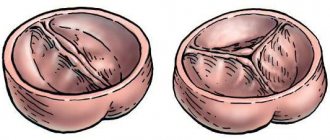Congenital heart defects are various structural defects of the heart that are present in a person from the moment of birth. Of course, such defects can have an impact on a person's life due to the fact that they change blood flow in the heart, and this in turn affects the functioning of the entire body. To begin with, we will describe how the heart works in an adult normally and how the heart works in a fetus, including a newborn child.
Anatomy of the blood circulation
The heart is a 4-chambered organ that has 2 ventricles and 2 atria (right and left). Between the right ventricle and the right atrium there is a tricuspid valve, and between the left ventricle and the left atrium there is a bicuspid valve. From the left ventricle comes the aorta, and from the right the pulmonary artery, which also have valves (semilunar).
Circulation circles
Blood circulation is carried out in two circles: the systemic circulation (BCC) and the pulmonary circulation (PCC). The systemic circulation begins from the left atrium - through the aorta, which carries oxygenated blood (aortic blood) to all organs of the body (brain, kidneys, liver, stomach, limbs, and so on) - it goes from the aorta to the arteries, from the arteries to small arterioles and then directly into the capillaries. There, at the level of capillaries, all types of exchange take place - this is a thin vessel that carries out a huge amount of work - capillary blood circulation is a whole system that works for the entire body. Blood exchange occurs in the capillaries - arterial blood turns into venous blood. First, venous blood is taken into small vessels and veins, and then into large veins, which already pass into the superior vena cava (from the upper part of the body) and into the inferior vena cava (from all organs and systems) and all this blood enters the right atrium.
Human circulation
Systemic circulation (BCC): left ventricle - arterial blood - venous blood from all organs - right atrium.
The pulmonary circulation is as follows: venous blood entering the right atrium flows from the right atrium into the right ventricle, from where through the so-called pulmonary arteries it enters directly into the lungs, where gas exchange (oxygen saturation) takes place in the alveoli and then this oxygenated blood flows The pulmonary veins gradually enter the left atrium, and then the left ventricle.
Pulmonary circulation (pulmonary circle): right ventricle - venous blood - lungs - left atrium.
During a lifetime (if we take the average life expectancy), about 2.5 billion heartbeats occur in the human body. The heart does a tremendous job, pumping up to 200 million liters of blood during a lifetime. Usually 2.5 liters of blood are involved in a person’s blood circulation - this amount is enough, and the rest of the blood (the body contains 5-6 liters of blood) is located in the organs. The contraction of the heart when blood is ejected into the vessel is called atrial systole. It is very short in time and lasts only 0.1 seconds. Ventricular systole occurs in 0.3 seconds, and then there is a pause lasting 0.4 seconds, during which the heart rests. Thus, the entire cardiac cycle is completed in less than 1 second—about 0.8 seconds. The valves that connect the atria to the ventricles and the valves that connect the ventricles to the aorta and pulmonary artery are made of fibrous tissue. The valves serve to seal tightly (normally they close very tightly), to prevent blood from flowing back from the vessels into the atrium or ventricle. However, there are cardiac pathologies, such as heart valve insufficiency or infection, that cause damage to the valve tissue, resulting in incomplete closure of the valve.
- Types of valve insufficiency:
- mitral valve insufficiency
- tricuspid valve insufficiency
- aortic valve insufficiency
In addition, there is such a pathology as stenosis of the opening between the atrium and the ventricle or stenosis of the aortic opening. In these cases, due to a violation of the condition of the valve apparatus, blood circulation is disrupted, blood can flow back or stagnate in the ventricles, pressure in the lungs increases and all this causes circulatory failure, clinically manifested by symptoms in the form of pain, shortness of breath, palpitations, cyanosis of the skin, edema and etc.
Blood circulation in the fetus and newborn baby
blood circulation in the fetus begins from the 5th week of pregnancy and differs from the blood circulation of an adult by the presence of the so-called foramen ovale, which is located between the atria. Blood from the placenta, entering through the umbilical vein directly into the inferior vena cava of the fetus, mixes with its blood and enters the right atrium. Then through the foramen ovale it enters the left atrium, then into the left and right ventricles and then goes through the systemic circulation. The second feature of the fetal circulation is a patent aortic duct - when blood from the right ventricle can be discharged directly into the pulmonary artery and then into the descending aorta and thus participate in the circulation. Normally, both of these openings close after childbirth. If the closure of these holes does not occur after childbirth, congenital heart defects form.
- Congenital heart defects in pregnant women:
- ventricular septal defect
- atrial septal defect
- pulmonary stenosis
- tetralogy of Fallot
Tetralogy of Fallot includes aortic stenosis, right ventricular hypertrophy, right-sided aorta, and atrial septal defect. The combination of these four defects at the same time is called tetralogy of Fallot.
Is it possible to give birth
During pregnancy, the load on the heart increases. For example, in the last trimester there is an increase in body weight (about 10 kg), and an increase in water level by an average of 4.8 liters.
An increase in sodium occurs from the 10th week of gestation. The blood circulation changes, a branch of the uteroplacental blood flow is added, which requires a certain amount of blood.
All these natural processes negatively affect the course of pregnancy of the “heart”.
Cardiac pathology is not an absolute contraindication to pregnancy. Such pregnant women are at risk of developing complications associated with the peculiarities of the course of pregnancy.
They are regular “clients” of the cardiologist and the ultrasound diagnostic room.
Thanks to modern medicine, congenital heart disease in women is operated on, the organ anomaly is corrected, and the patient leads a normal life.
An inoperable heart defect may prevent you from planning a child.
Three critical periods
- 10-12 weeks of gestation. The first manifestations of rheumatic complications. During this period, the issue of termination of pregnancy according to indications, or its prolongation, is decided.
- 26-32 weeks of gestation. Due to the increased load on the heart muscle, the patient is treated in a hospital setting;
- 37-40 weeks of gestation. A pronounced overload of the cardiovascular system develops. Quite often, labor with congenital heart disease occurs earlier than expected.
Atrial septal defect
Atrial septal defect
Atrial septal defect is the most common defect among all other heart defects. With this defect, blood is shunted from left to right and pulmonary blood flow increases. Due to the fact that pulmonary blood flow increases, increased intrapulmonary pressure appears, and pulmonary hypertension can develop, which is accompanied by pulmonary edema. Often the disease can be asymptomatic and the girl feels quite well in the absence of significant stress, she can even play sports throughout her life, but during pregnancy this defect becomes very dangerous. The danger is that during pregnancy pulmonary hypertension can develop, which can cause heart failure, hypoxia, the risk of bleeding during childbirth and pulmonary embolism. These are very dangerous conditions, so it is recommended to terminate the pregnancy. In general, in the presence of any congenital heart defect, doctors are more inclined to terminate the pregnancy. However, sometimes a woman, feeling more or less well, does not want to terminate the pregnancy, and then, of course, doctors must meet the woman halfway. She is admitted to the cardiology department, and then to the pregnancy pathology department. Almost the entire pregnancy is under the supervision and control of a cardiologist and obstetrician-gynecologist, observes a passive regime, regularly undergoes oxygenation, treatment with drugs (cardiac glycosides) and correction of hypovolemia is performed. In this case, the woman gives birth through the natural birth canal. The application of obstetric forceps, as for example in case of rheumatic heart disease, is not recommended in this case, because this can cause thromboembolism or pulmonary edema. When obstetric forceps are applied, the fetus is removed quickly, due to which the intra-abdominal pressure changes sharply and the pressure in the pulmonary circulation increases - acute heart failure occurs.
What complications may arise?
If the diagnosis is not made in time, or the woman does not see a doctor, then as the contractility of the left ventricle weakens, cardiac asthma occurs. It can begin at night in the form of a sudden attack of suffocation, rapid heartbeat with a sharp loss of strength, and profuse cold sweat. It becomes difficult to be in a horizontal position, so to ease breathing the patient has to sit down and lower her legs down.
This condition quickly turns into pulmonary edema - sputum with blood appears, bubbling wheezing, blood pressure drops, the pulse becomes weak and thread-like. In the absence of immediate medical attention, death is likely.
Right ventricular dysfunction manifests itself much more quickly because the myocardium of this half of the heart is weaker. Swelling of the limbs, distension and heaviness in the liver area occurs, the veins of the neck swell, breathing is impaired, pain in the heart and a drop in pressure increase catastrophically.
Watch the video about the combination of heart disease and pregnancy in a woman:
Ventricular septal defect
Ventricular septal defect
The severity of the woman’s condition depends on the size of this defect: with a small hole, when only a small amount of blood can flow from the left atrium to the right or vice versa from the right atrium to the left, such a pathology proceeds more or less favorably, while the pulmonary blood flow increases slightly, but with large defect, when a large amount of blood is discharged from the left atrium to the right through this defect, the blood enters the system of pulmonary veins, which go to the lungs - this, of course, significantly increases the pressure in the pulmonary circulation system, causes ventricular hypertrophy, increased intrapulmonary pressure, cardiac failure, pulmonary embolism and pulmonary edema. Management of pregnancy and childbirth occurs in the same way as in the previous case, that is, either the pregnancy is terminated if it is a large defect, because here the likelihood of a bad outcome for the woman and the fetus increases even more, or, with a small defect of the interventricular septum, the pregnancy is carried out under strict under the supervision of a doctor.
Features of childbirth
Most often, patients prepare for childbirth in a hospital, starting from 35 to 37 weeks. If a deterioration in blood circulation is suspected, this period can begin much earlier. If the defect has a compensated course, then women are prescribed therapy to strengthen the myocardium, prevent heart failure, and rhythm disturbances.
For this category of women in labor, pain relief during childbirth is indicated to prevent additional release of hormones by the adrenal glands. The entire period of natural childbirth takes place under the control of blood pressure and ECG. The most difficult process is pushing. With their onset, the heart experiences maximum stress. Therefore, a perineal dissection can be performed to shorten this period.
If circulatory decompensation begins, the child is removed using obstetric forceps.
In order to minimize the risks for mother and child, a caesarean section is performed. It is recommended for most pregnant women with heart defects, and it is mandatory in the following cases:
- active inflammatory process (fever, heart pain, signs of exacerbation in blood tests);
- complex or decompensated defect;
- severe circulatory failure;
- abnormal position of the fetus, placenta or other obstetric pathology;
- nephropathy;
- danger of retinal detachment;
- high blood pressure resistant to medications.
Patent aortic duct
Such a heart defect in pregnant women does not occur often precisely because surgical care is quite well developed today. With timely surgical treatment of an open aortic duct before pregnancy, hemodynamics are well restored and the woman can bear pregnancy. But if it is not operated on, then the same changes in hemodynamics occur as with a ventricular septal defect, when blood is discharged from left to right in the heart and it enters the pulmonary circulatory system, causing all the same changes there: pulmonary hypertension, pulmonary edema, heart failure , pulmonary insufficiency - this has a very serious impact on the course of pregnancy.
Complications, as a rule, arise only with a large diameter of the open aortic duct.
Symptoms
The symptoms of heart defects differ depending on the affected area and the complexity of each specific case. But there are general characteristic signs that indicate the presence of pathology in the cardiovascular system, appearing in a child in the first days after birth. Among them:
- the occurrence of shortness of breath and difficulty breathing;
- cyanosis and pallor of the skin (cyanosis);
- sudden changes in appetite;
- baby's anxiety when breastfeeding;
- low activity and fatigue;
- causeless screams;
- the appearance of heart murmurs;
- symptoms of heart failure, in particular, irregular heartbeat, increased breathing, swelling;
- coldness in the extremities;
- malfunctions of the heart detected during diagnosis.
ATTENTION! Most of these signs cannot be identified before a woman gives birth, so it is important to pay attention to the well-being of the expectant mother, check her hormonal levels and monitor the progress of pregnancy.
Coarctation of the aorta
Coarctation of the aorta is an obstacle to blood flow and due to this, systolic blood pressure increases, left ventricular hypertrophy develops, blood circulation in the lower part of the body decreases, and due to the fact that the blood circulation in the lower part of the body is impaired, on the contrary, the blood circulation in the upper part of the body increases, which leads to dilation of the aorta and delamination of its wall. Coarctation of the aorta during pregnancy is a very serious pathology in which it is better to terminate the pregnancy.
Symptoms that may indicate congenital and acquired defects
A compensated defect may not cause symptoms until the second half of pregnancy. After the heart can no longer withstand the overload, the following clinical signs increase:
- difficulty breathing - first with intense physical activity, and then at rest;
- increased heart rate and palpitations;
- fast fatiguability;
- change in skin color after exercise - pallor or cyanosis;
- heart rhythm disturbance;
- headache;
- fainting conditions;
- sharp fluctuations in blood pressure;
- the appearance of pain in the heart.
Subsequently, circulatory failure appears in the form of swelling of the legs, enlarged liver, swelling of the neck veins, attacks of suffocation, cough with bloody sputum, accumulation of fluid in the abdominal cavity and chest.
Tetralogy of Fallot (blue heart defect)
With tetralogy of Fallot, blood is shunted from right to left, the pressure in the right side of the heart increases, blood with a low oxygen content enters the systemic circulation, so a woman with this defect usually faints, due to general hypoxia, the fetus often suffers, and acute cardiac arrest develops. failure. And only after surgical correction can this pregnancy be carried to term - without surgical treatment of tetralogy of Fallot, the likelihood of a successful pregnancy is extremely low, moreover, a fatal outcome is possible for the woman.
Management of childbirth with heart disease
The issue of medical tactics during childbirth is of particular importance. The best choice is early hospitalization at 36-37 weeks of pregnancy. The delivery plan is drawn up in consultation with the participation of an obstetrician, cardiologist or therapist and anesthesiologist. The choice of method is strictly individual for each patient, depending on the situation.
Modern medicine has a sufficient arsenal of diagnostic tools to promptly prevent pregnancy complications in women with heart defects. The following methods are usually used:
- Electrocardiography is the recording of electrical phenomena occurring in the heart muscle when it is excited. This study allows you to register changes in the heart muscle by changes in electrical impulses.
- Phonocardiography is a method of recording sounds (tones and noises) resulting from the activity of the heart. It is used to assess heart function and recognize abnormalities, including valve defects.
- Echocardiography (ultrasound of the heart). It is used to study blood circulation and cardiodynamics (heart function), determine the size and volume of the cavities of the heart, and assess the functional state of the heart muscle. The method is harmless to the mother and fetus.
- Load testing is used to assess the functional state of the heart muscle. Load tests on a bicycle ergometer are also used when examining pregnant women - during this test, an ECG is taken for the patient at different intensities of physical activity.
- The study of the function of external respiration and the acid-base state of the blood involves studying lung capacity and blood oxygen saturation at rest and during exercise. The study allows you to determine how adequate the blood oxygen saturation is, i.e. How well the heart can cope with the load at the moment.
- Blood tests are usually a standard test that is performed when examining all pregnant women. However, in this case, the doctor pays special attention to the state of the blood coagulation system.
- Fetal ultrasound, cardiotocography , which are regularly performed after 28 weeks to assess the condition of the placenta and fetus. These studies help determine whether the fetus is suffering from a lack of oxygen and nutrients. In addition, fetal ultrasound allows you to identify possible malformations of the child even before birth and take appropriate measures - from urgent surgery after delivery to termination of pregnancy.
The advantage remains with the natural method of delivery. In case of compensated heart disease, therapy is carried out aimed at preventing heart failure and supporting the heart, preventing pulmonary edema, and, if arrhythmia is possible, ECG monitoring. Adequate labor pain relief is provided, as fear and pain lead to additional stress on the heart.
As a rule, the most difficult period of labor - pushing (the period of expulsion of the fetus) - is tried to be shortened with the help of an episiotomy - incision of the perineum. Switching off pushing (application of obstetric forceps) is carried out in case of circulatory problems.
Many doctors believe that full-term delivery by cesarean section reduces the burden on the cardiovascular system and reduces mortality among pregnant women with heart defects.
Caesarean section for heart defects is performed in the following cases:
- with an active rheumatic process (fever, pain in the relevant organs, characteristic changes in tests);
- with severe heart disease with severe left ventricular failure and no effect of drug therapy;
- when a heart defect is combined with obstetric pathology requiring surgical delivery.
Successful delivery of patients suffering from severe congenital and acquired heart defects can be facilitated by delivery under conditions of hyperbaric oxygenation.
After the birth of the fetus and the passage of the placenta, there is a rush of blood to the internal organs (and primarily to the abdominal organs) and a decrease in blood circulation in the vessels of the brain and the vessels feeding the heart muscle. Therefore, to prevent deterioration of the condition, immediately after the birth of the child, the woman is given medications to ensure normal heart function.
Aortic defects
Aortic defects can be congenital or acquired.
- Frequent aortic defects in pregnant women:
- aortic duct stenosis
- aortic duct insufficiency
- aortic valve stenosis
With aortic valve stenosis, cardiac output is limited, coronary blood flow is reduced, myocardial ischemia very often occurs, which occurs as a result of general hypoxia and poor blood supply to the myocardium of the heart, and acute left ventricular failure develops under any load on the heart. With aortic valve stenosis, the prognosis is very unfavorable and termination of pregnancy is indicated. Pregnant women with congenital heart defects always require an individual approach to pregnancy management. The likelihood of a successful pregnancy or the need to terminate it depends on the severity of the threshold, on the development of heart failure, on the development and severity of complications that arise. Absolutely all heart defects have an adverse effect on the fetus. In addition to the development of fetal hypoxia, there is a significant risk of the formation of similar congenital heart defects in the fetus (from 15 to 50% of children). Perinatal mortality is quite high and reaches 30%. In addition, due to the fact that women’s bodies are weakened, many of them develop complications such as endocarditis, myocarditis, pericarditis in the postpartum period, thromboembolic complications often occur, and the risk of death is very high.
Therefore, the decision on the possibility of carrying a pregnancy must be made by a council of doctors, which should include cardiologists, therapists and obstetricians-gynecologists, and the latter takes into account the woman’s wishes.
How will the pregnancy go?
The prognosis of pregnancy depends on the degree and combination of damage, as well as on the activity of the rheumatic process (in other words, on whether it is currently exacerbating) and on the severity of circulatory disorders.
The issue of maintaining or terminating a pregnancy is decided collectively by a cardiologist and an obstetrician-gynecologist in each case individually. If pregnancy occurs after heart surgery, you need to consult a cardiac surgeon. You should know that corrective heart surgery does not always lead to the elimination of organic changes in the valve apparatus or the elimination of congenital developmental anomalies. Often, after surgical treatment, there is a relapse of the underlying disease, for example, in the form of restenosis (re-narrowing) after some operations.
It is extremely difficult to decide whether pregnancy is permissible in women with prosthetic heart valves. They are at high risk of developing blood clots, so pregnant women with mechanical valves constantly receive anticoagulant (anti-clotting) therapy.
Of course, the issue of continuing pregnancy in women with cardiovascular diseases is best decided in advance, before its onset. The basis for proper management and treatment of such pregnant women is an accurate diagnosis that takes into account the cause of the disease.
Defects with blood discharge to the right serve as a contraindication to pregnancy, as well as any type of defect with decompensation, in which circulatory failure has already formed.
Indications for caesarean section
ACS does not exclude the development of negative consequences for mother and child. When preparing for surgery, special attention is paid to the homeostasis system and the condition of the heart muscle and its valves.
Pregnancy with heart defects - indications for cesarean section:
- Combined insufficiency of the mitral and aortic valves;
- II–III stage of mitral stenosis;
- Endocarditis of bacterial etiology;
- Complications after correction of a heart defect;
- Valve prostheses (including multivalve);
- History of thromboembolism;
- Coarctation of the aorta.
Emergency surgery is performed during increasing fetal hypoxia, during presentation of the “baby place” and during premature placental abruption.
Absolute contraindications to surgical delivery:
- Cirrhosis of the liver;
- Cardiomegaly;
- Blue-type congenital heart disease with a complex course;
- Severe decompensated circulation as a result of cardiac abnormalities;
- Extreme degree of pulmonary hypertension.
Pregnant women with these signs of cardiac anomalies have an unfavorable prognosis at the time of labor and throughout the gestational period.
Author: Elena Yuryevna, obstetrician-gynecologist of the highest category Specially for the site kakrodit.ru
Causes
Heart disease in pregnant women is a leading factor in deaths. This is due to the inability of the compensatory function to cope with significant loads on the body. Excessive stress on the heart can lead to death, despite the high level of development of medicine. Pathologies of the cardiovascular system occupy third place among the factors of female and infant mortality.
During pregnancy, normal physiological changes also occur, which, against the background of associated complications, can provoke heart disease in the expectant mother.
Those patients who had problems with the cardiovascular system even before pregnancy suffer more from heart disease. Initially healthy pregnant women can also develop cardiac pathologies against the background of toxicosis and obstetric cardiomyopathy.
Hemoglobin levels and anemia
Since the increase in circulating blood volume occurs mainly due to plasma, and the number of red blood cells increases slightly (no more than 0.5 times), so-called physiological anemia is recorded in pregnant women. Unfortunately, it can quickly turn into a pathological form.
The lower limit of normal hemoglobin level during pregnancy is 110 g/l.
Forms of the disease
- Valve insufficiency. Congenital anomaly of the heart valve (1 or more). When several valves are involved, a combined defect occurs. The edges of the valve do not fit closely together, and blood enters through the resulting gap.
- Heart valve stenosis. Thickening of the walls prevents full opening, and the heart muscle does not receive the required volume of blood;
- Combined defect. Stenosis and insufficiency were detected on one valve.
There are about 50 types of heart defects, but none is an absolute contraindication to pregnancy and childbirth.
During the period of pregnancy planning, a woman undergoes a large number of studies, where the result says that pregnancy is allowed or prohibited.
Treatment
What can you do
If heart disease is detected during pregnancy, it is important to strictly follow all the recommendations of specialists. Maintaining a daily routine, changing your diet, and avoiding physical and emotional stress are important components of a good pregnancy with heart disease.
In no case should you refuse drug treatment and surgical intervention. These methods are used only if necessary, taking into account an assessment of your condition and the risk to you and the child.
You should not let the disease take its course and attribute all complications to pregnancy. Even physiologically normal abnormalities can develop into serious anomalies incompatible with life.
Self-medication is also not the best way to solve the problem. Traditional medicine can only worsen the condition of mother and baby.
What does a doctor do
When registering a pregnant woman with existing cardiac pathologies, the gynecologist will refer the patient under the supervision of a cardiologist. In this case, the course of the entire pregnancy is under the total control of specialists.
If heart disease worsens or is detected in a pregnant woman, inpatient or outpatient treatment may be prescribed. Its scheme is determined by the condition of the expectant mother and her fetus, the clinical picture and the causes of the disease. If medication or surgical intervention is needed, the doctor informs the patient about all the possible consequences on the female and children's body, as well as the consequences of refusing medications. Only the pregnant woman herself can assess the risk and choose a treatment regimen.
From the moment the disease is detected, the doctor and his patient need to think in advance about the tactics of labor management, the method of delivery and the date of prenatal hospitalization.
Features of gestation with congenital anomalies
Previously, children with congenital defects were doomed to death at an early age or a long, painful existence. Currently, the level of development of medicine allows them to live to childbearing age and have their own offspring. But pregnancy with a heart defect in the mother has its own course.
Atrial septal defect
The disease often occurs without significant symptoms. Sometimes, depending on the severity of the defect, the doctor may hear a systolic murmur. A feature of hemodynamics is the discharge of blood from right to left and increased pulmonary blood flow. But hypertension in the lungs rarely develops.
The course of pregnancy depends on the severity of the condition. With severe pulmonary hypertension, Eisenmenger syndrome develops - this is irreversible pulmonary hypertension, in which the probability of death reaches 50%. But with a mild course, only regular monitoring and echocardiography are required. In 15% of cases, the disease is inherited.
Ventricular septal defect
The severity of the condition and the course of gestation depend on the size of the hole. If the discharge of blood from left to right is insignificant, then pulmonary pressure does not increase. Otherwise, the pathology leads to pulmonary hypertension. Increased load on the left ventricle leads to its hypertrophy, and pulmonary hypertension leads to an increase in the size of the right ventricle of the heart.
If the progression of the pathology was observed even before conception, then during a physiological increase in blood volume this can lead to the rapid development of heart failure, turning into Eisenmenger syndrome. When performing surgical correction of the pathological condition even before conception, the gestational period passes without complications. In 22% of cases the disease is inherited.
Aortic stenosis
Narrowing of the pulmonary artery opening may not manifest itself before pregnancy. During pregnancy, unpleasant symptoms may appear:
- angina attacks;
- dyspnea;
- acute left ventricular failure.
During pregnancy, the load on the heart increases significantly. Therefore, with pronounced narrowing of the orifice, tachycardia, insufficient blood supply to the coronary arteries, frequent fainting and low blood pressure are observed.
With severe pathology, maternal mortality rates reach 15%, so the woman is recommended to terminate the pregnancy.
Treatment of aortic stenosis is possible. To do this, they prescribe medications to prevent the development of heart failure and bed rest. Those who have a valve prosthesis are required to prevent blood clots using Heparin injections. If Warfarin was used before conception, it is discontinued in the first two trimesters.
Patent ductus arteriosus
Aortic heart defects, due to the fact that they are successfully identified and operated upon in childhood, are rare in adults.
With a patent ductus arteriosus, both ventricles are also overloaded with blood volume, which during gestation can cause the development of heart failure. With decompensation, there is a high risk of developing pulmonary hypertension and pulmonary edema, accompanied by shortness of breath, hemoptysis and the appearance of pink foam at the mouth.
With a slight deviation in development, there is no serious impact on bearing a child. The probability of inheriting the pathology is 15%.
Coarctation of the aorta
The anomaly is often diagnosed in combination with valve defects (bicuspid valve) and aneurysms of the cerebral arteries.
The disease is a sharp narrowing of the vessel at the exit of the heart. There is an obstruction to blood flow, and the blood pressure during systole is quite high. This leads to left ventricular hypertrophy and deterioration of blood supply to the lower body.
The course of pregnancy is normal in most cases. But insufficient blood flow can lead to intrauterine growth retardation. If ventricular hypertrophy existed long before conception, then there is a high risk of developing heart failure.
Features of changes in the structure of vascular tissue can result in aortic dissection and severe bleeding. Therefore, clinical guidelines indicate the need to take antihypertensive drugs to prevent this condition.
Pulmonary valve stenosis
The prognosis for the course and development of pregnancy complications depends on the degree of stenosis. A small change in the size of the hole does not lead to serious consequences. In severe stenosis, the ejection of blood from the right side is impaired, which leads to ventricular hypertrophy.
A pregnant woman is threatened with the development of shortness of breath after slight exertion and increased fatigue. A natural increase in circulating blood volume leads to heart failure.
Treatment includes:
- prevention of endocarditis;
- correction of hypervolemia;
- treatment of right ventricular failure;
- surgical correction in the form of balloon valvuloplasty or valvotomy (performed if drug therapy is ineffective).
Tetralogy of Fallot
Girls with this pathology are operated on at an early age, otherwise they are not able to survive for a long time. Developmental defects include:
- dextroposition of the aorta;
- pulmonary stenosis,
- hypertrophied right ventricle;
- defect of the septum between the ventricles.
This developmental anomaly is classified as cyanotic. With it, blood is discharged into the systemic circulation without previous full gas exchange in the lungs. Internal organs do not receive oxygen in the required quantity.
The course of pregnancy depends on the degree of gas exchange disturbance. If saturation is reduced, hematocrit is reduced to 60% or lower, and hemoglobin is saturated only by 80%, as well as with frequent fainting, the prognosis for bearing a child is unfavorable.
Some surgical operations to correct developmental anomalies give a good effect before pregnancy, but against their background, bearing a child is impossible. There is an increase in heart failure, and there is a high risk of losing the pregnancy.
Children suffer from a lack of oxygen, which leads to developmental delays and the birth of low birth weight babies. Some pregnant women benefit from inhaled oxygen.
Eisenmenger syndrome
Develops as a result of a number of cyanotic defects. Increasing pulmonary hypertension becomes irreversible. In this case, the gradual progression of the pathology leads to the discharge of oxygen-poor blood into the systemic circulation. The number of red blood cells compensatory increases. This simultaneously affects blood clotting and increases the chance of thromboembolism.
The prognosis for pregnancy is unfavorable. Insufficient blood supply leads to intrauterine growth retardation, and children may be born immature. A high percentage of perinatal mortality is recorded.
Therefore, if Eisenmenger syndrome develops during pregnancy, it is recommended to terminate it. If a woman insists on conservation, this requires careful medical supervision. Strict bed rest is prescribed, and prevention of thromboembolism, hypovolemia and heart failure is carried out.
Such patients should give birth vaginally, but straining in the second period must be excluded. To do this, obstetric forceps are applied. Caesarean section for Eisenmenger syndrome is contraindicated because it is accompanied by a high maternal mortality rate of up to 75%. This is explained by a sharp drop in pressure after extraction of the fetus and as a result of blood loss.
Marfan syndrome
This is a hereditary disease that is transmitted in an autosomal recessive manner. The risk of having a child with a similar pathology reaches 50%. Marfan syndrome is associated with a congenital defect in the development of connective tissue. Clinically, this is accompanied by joint hypermobility. For the heart, this threatens the development of valve degeneration (the mitral valve is most often affected), as well as the formation of an aortic aneurysm.
Mitral valve prolapse with mild regurgitation does not pose a danger to a pregnant woman. But if there is a significant retention of blood in the heart, then left ventricular hypertrophy develops, which over time leads to failure.
Pregnant women with this developmental disorder often experience aortic dissection, accompanied by massive bleeding and death. But modern medical advances make it possible to reduce the number of pathological complications and maternal mortality.
Beta blockers are required throughout pregnancy to help reduce the effect on the heart and the stress on the aorta.
The probability of a child inheriting the above pathologies ranges from 10 to 20%.
Prevention
The best way to prevent heart disease during pregnancy is to diagnose and treat it before conception. This will avoid serious exacerbations that will negatively affect the development of the fetus and the course of pregnancy.
In order to prevent abnormal problems with the cardiovascular system from appearing during pregnancy, it is important to follow a number of simple rules:
- Follow a daily routine. This will protect the heart from unexpected sudden loads.
- Walk outdoors every day and get plenty of rest. Pregnant women should have 8 hours of sleep at night and short sleep during the day. This will allow the heart to work better and spend more time at rest.
- Follow the rules of rational nutrition. Overeating causes not only the gastrointestinal tract to function intensively, but also the cardiovascular system. And a large weight gain additionally increases blood flow and the load on the heart.
- Avoid activities that require a lot of physical strength and evoke strong emotions. The cardiac load increases significantly.
- Visit your doctor regularly and undergo all necessary tests.
- Take vitamins or vitamin-mineral complexes prescribed by your gynecologist.
Heart defects in the fetus during pregnancy: methods of detection and tactics of action
The term “congenital heart disease” is a cause of great concern for parents. The situation becomes more complicated if this diagnosis was made before the baby was born.
If children with congenital heart disease have already been born in the family, or the woman is over 35 years old, pregnancy should be planned especially carefully. You need to lead a healthy lifestyle, make sure there are no infections or cure existing abnormalities.
Of course, it will not be possible to completely minimize the risks of the disease. There is only one piece of advice here: undergo all mandatory screenings and other examinations indicated during pregnancy on time.










